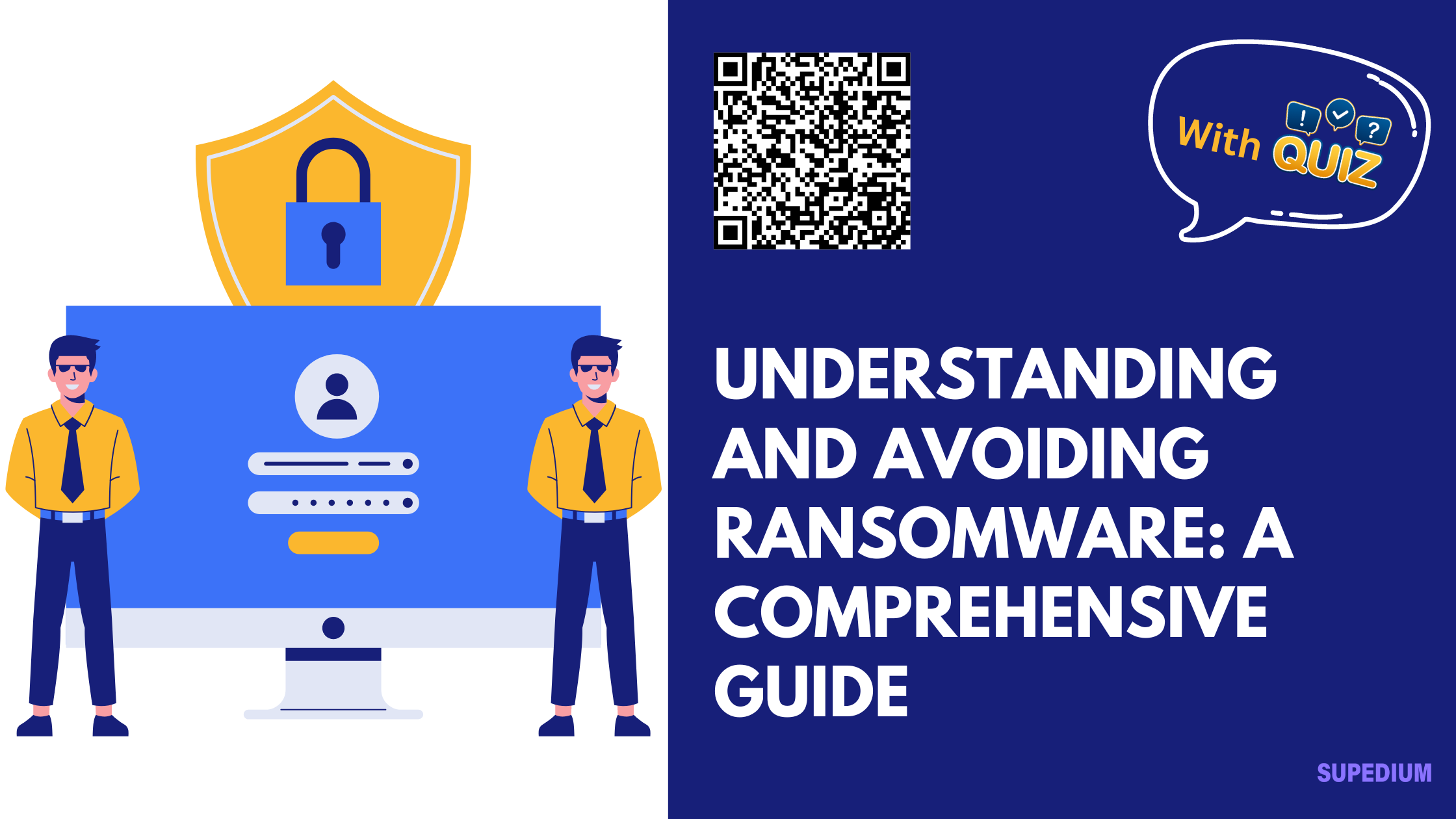Table of Contents
![]()
Introduction to Ransomware
Ransomware is a form of malicious software designed to block access to a computer system or data until a ransom is paid. It has evolved significantly since its early days, becoming more sophisticated and damaging. Ransomware attacks can cripple individuals, businesses, and even entire organizations, making it crucial to understand and address this growing threat.
Definition and History
Ransomware first emerged in the late 1980s, with early examples like the AIDS Trojan, which encrypted files on an infected system and demanded a ransom to restore access. Since then, ransomware has evolved into a major cyber threat, with more advanced encryption techniques and more aggressive extortion tactics.
How Ransomware Works
Ransomware typically works by encrypting files on a victim’s system, rendering them inaccessible. The attacker then demands payment, usually in cryptocurrency, in exchange for the decryption key. Modern ransomware often threatens to release sensitive data if the ransom is not paid.
Common Types of Ransomware
- Crypto Ransomware: Encrypts files on the infected system and demands a ransom for the decryption key.
- Locker Ransomware: Locks the user out of their device or operating system but does not encrypt files.
- Scareware: Displays fake warnings or alerts to trick users into paying for a supposed fix.
Understanding Ransomware Threats
Attack Vectors
Ransomware can be delivered through various attack vectors:
- Phishing Emails: Malicious attachments or links in emails that, when clicked, download ransomware.
- Malicious Websites: Websites that exploit vulnerabilities in browsers or plugins.
- Exploit Kits: Automated tools that target vulnerabilities in software.
Typical Targets and Motivations
Ransomware targets can range from individual users to large corporations. Attackers often seek high-value targets with sensitive or critical data, aiming for a substantial ransom payout. High-profile organizations, healthcare providers, and government agencies are frequent targets due to their valuable data and often inadequate defenses.
Case Studies of Notable Ransomware Attacks
- WannaCry (2017): This ransomware attack affected hundreds of thousands of computers worldwide, exploiting a vulnerability in Microsoft Windows. It encrypted files and demanded a ransom in Bitcoin.
- NotPetya (2017): Initially disguised as ransomware, NotPetya was a destructive malware that caused extensive damage and was attributed to a state-sponsored attack.
Identifying Ransomware
Symptoms of Infection
Identifying ransomware early can mitigate damage. Common symptoms include:
- Files becoming inaccessible or appearing with strange extensions.
- Unusual system behavior, such as slow performance or unexpected pop-ups.
- Ransom notes or alerts demanding payment for file recovery.
Detection Methods
- Antivirus Software: Modern antivirus programs can detect known ransomware variants based on signatures and behavior.
- Behavioral Analysis: Tools that monitor system behavior for suspicious activity indicative of ransomware.
Tools and Software for Identification
Several tools can help identify ransomware, including:
- Malwarebytes: Offers real-time protection and scanning.
- Ransomware Identification and Protection Tools: Specialized software designed to detect and prevent ransomware attacks.
Preventing Ransomware Attacks
Best Practices for Cybersecurity
- Regular Updates and Patches: Keep operating systems, software, and applications up to date to protect against vulnerabilities.
- Use Strong, Unique Passwords: Implement multi-factor authentication and ensure passwords are robust.
Importance of Regular Backups
Regular backups are crucial for ransomware defense. Implement a comprehensive backup strategy, including:
- Frequent Backups: Ensure backups are performed regularly.
- Offsite Storage: Store backups in a secure location separate from the primary network to prevent ransomware from encrypting them.
Employee Training and Awareness Programs
Educating employees about cybersecurity best practices can reduce the risk of infection. Training should cover:
- Recognizing Phishing Attempts: Identifying suspicious emails and avoiding clicking on links or attachments from unknown sources.
- Safe Internet Practices: Avoiding risky websites and downloads.
Secure Configurations and Network Defenses
- Firewalls and Intrusion Detection Systems: Implement and configure firewalls to block unauthorized access and use intrusion detection systems to monitor network traffic.
- Least Privilege Principle: Limit user access rights to the minimum necessary to reduce the risk of ransomware spreading.
Responding to a Ransomware Attack
Immediate Steps to Take
- Isolate Infected Systems: Disconnect affected devices from the network to prevent further spread.
- Contact Authorities: Notify law enforcement and relevant agencies for guidance and support.
Communicating with Stakeholders
Transparent communication with stakeholders, including employees, customers, and partners, is essential. Provide updates on the situation and steps being taken to address it.
Decrypting Files and Data Recovery Options
- Decryption Tools: Some ransomware variants have decryption tools available from security vendors.
- Professional Data Recovery Services: For severe cases, consider engaging specialized data recovery experts.
Assessing and Addressing the Damage
Conduct a thorough assessment to understand the scope of the attack and the impact on systems and data. Develop a plan to restore operations and strengthen defenses.
Legal and Ethical Considerations
Ransom Payment: Pros and Cons
Paying the ransom may seem like a quick solution but can encourage further attacks and does not guarantee file recovery. Consider the potential consequences and consult with cybersecurity experts and legal advisors.
Legal Obligations and Reporting Requirements
Organizations may be required to report ransomware attacks to regulatory bodies, especially if personal data is compromised. Understanding and complying with legal requirements is essential.
Ethical Considerations of Paying the Ransom
Paying a ransom raises ethical concerns, including contributing to the profitability of criminal enterprises and the potential funding of illicit activities. Weigh these considerations carefully before making a decision.
Future of Ransomware
Emerging Trends and Evolving Tactics
Ransomware attacks are becoming more sophisticated, with trends such as:
- Double Extortion: Threatening to release stolen data in addition to encrypting files.
- Ransomware-as-a-Service: Renting ransomware tools to other criminals, expanding the threat landscape.
Predictions for Ransomware Development
Future ransomware may utilize advanced encryption methods, target new systems and technologies, and employ more sophisticated evasion techniques.
How to Stay Ahead of New Threats
Staying informed about emerging threats and updating defenses accordingly is crucial. Regularly review and adapt cybersecurity strategies to address new vulnerabilities and attack methods.
Resources and Tools
Recommended Cybersecurity Tools and Services
- Antivirus and Anti-Ransomware Solutions: Invest in reputable security software.
- Backup Solutions: Use reliable backup services that offer secure storage.
Educational Resources and Training Programs
- Online Courses and Certifications: Enroll in cybersecurity training programs to stay updated on best practices.
- Webinars and Workshops: Participate in industry events to learn about the latest threats and solutions.
Support and Response Organizations
- CERT (Computer Emergency Response Team): Provides assistance and resources for dealing with cybersecurity incidents.
- Law Enforcement: Contact local and national law enforcement agencies for support and investigation.
Conclusion
Ransomware represents a significant and evolving threat to individuals and organizations. Understanding how ransomware works, identifying potential attacks, implementing preventive measures, and knowing how to respond effectively are crucial for mitigating the risk and impact of ransomware attacks. By staying informed and proactive, you can better protect yourself and your organization from this destructive cyber threat.






Be the first to comment